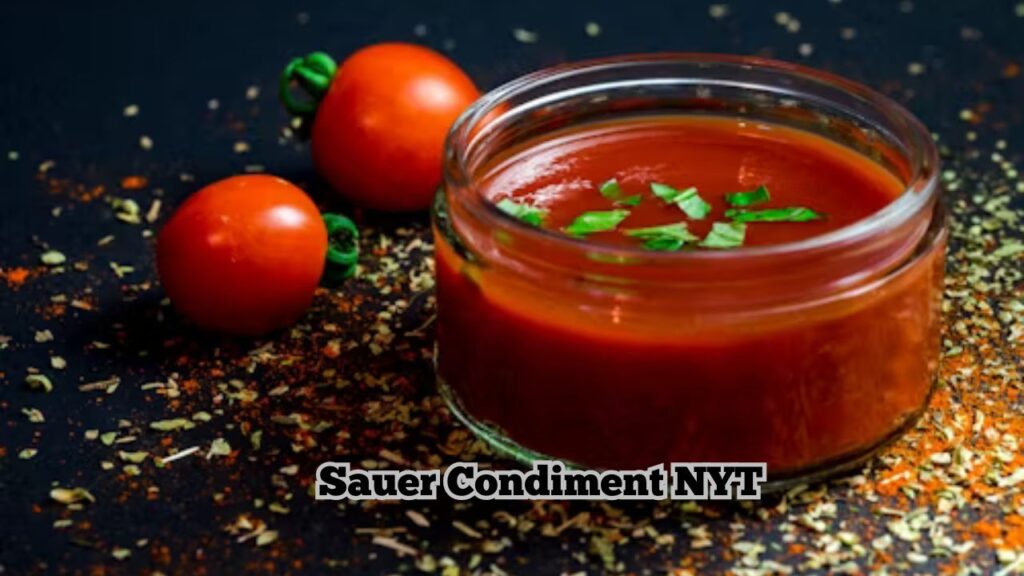Introduction
Sauer condiments, a staple in many culinary traditions, have gained significant recognition for their distinctive sour taste and versatile applications. Recently highlighted in the New York Times, these condiments are becoming a focal point for food enthusiasts and home cooks alike. This article delves into the fascinating realm of sauer condiments, exploring their origins, varieties, and culinary uses, as well as providing insights from the Sauer Condiment NYT feature.
Sauer Condiment NYT: A Tangy Introduction
The History and Evolution of Sauer Condiments
Sauer condiments, often synonymous with pickled and fermented foods, have a long and storied history. Originating from various cultures around the world, these condiments were initially developed as a means of preserving food, however Over time, they evolved into a beloved component of many cuisines, celebrated for their unique flavors and health benefits.
The Global Influence of Sauer Condiments
From the tangy sauerkraut of Germany to the spicy kimchi of Korea, sauer condiments have made a mark on global culinary practices. Each culture brings its own twist to these preserved foods, additionally resulting in a rich tapestry of flavors and textures. The NYT’s feature on sauer condiments highlights this diversity, showcasing how these tangy treats are enjoyed worldwide.
Also Read : https://thedocegroup.com : Discover the best Jettron Products
Varieties of Sauer Condiments: Sauer Condiment NYT
Traditional Sauer Condiments
Traditional sauer condiments include a range of pickled and fermented items. Some of the most notable are:
- Sauerkraut: Fermented cabbage with a distinctive sour taste, often used in German cuisine.
- Kimchi: A spicy, fermented vegetable dish from Korea, typically made with cabbage and radishes.
- Pickles: Cucumbers preserved in a vinegar or brine solution, popular in many Western cuisines.
- Fermented Soybeans: Known as miso or natto in Japanese cuisine, these are rich in umami flavors.
Modern Twists on Sauer Condiments
Modern chefs and home cooks are constantly innovating, creating new variations of sauer condiments. Some contemporary examples include:
- Pickled Beets: Sweet and tangy, these are often used in salads or as a side dish.
- Fermented Hot Sauces: Combining the heat of chili peppers with the sourness of fermentation for a complex flavor profile.
- Sauer Carrots: A crunchy, tangy addition to sandwiches and salads.
Culinary Uses of Sauer Condiments
Enhancing Flavors in Everyday Dishes
Sauer condiments are a fantastic way to add depth and complexity to a variety of dishes. Their sourness can balance out rich, fatty foods, making them a popular choice for pairing with meats and cheeses. Additionally, the umami notes present in many fermented condiments can enhance the overall flavor profile of a dish.
Sauer Condiments in Global Cuisines
These condiments are integral to many traditional recipes around the world. For example:
- German Bratwurst with Sauerkraut: A classic combination that highlights the tangy notes of the sauerkraut against the rich, savory sausage.
- Korean Bibimbap with Kimchi: A vibrant rice bowl topped with an assortment of vegetables, meat, and a generous helping of spicy kimchi.
- American Burgers with Pickles: The acidity of pickles cuts through the richness of the beef, adding a refreshing crunch.
Health Benefits of Sauer Condiment NYT
Probiotics and Gut Health
Fermented sauer condiments are renowned for their probiotic content, which can support gut health. The beneficial bacteria produced during fermentation can help balance the gut microbiome, potentially improving digestion and immunity.
Nutrient-Rich and Low-Calorie
These condiments are often low in calories but high in vitamins and minerals. For example, sauerkraut is a good source of vitamin C and fiber, making it a nutritious addition to meals without adding extra calories.
Sauer Condiment NYT: Insights from the Feature
Highlighting Cultural Significance
The NYT feature on sauer condiments emphasizes their cultural importance. Through interviews with chefs and food historians, the article explores how these condiments reflect the culinary heritage of different regions and their evolving role in modern cuisine.
Trends and Innovations
According to the NYT, there is a growing trend towards homemade and artisanal sauer condiments. Many people are turning to DIY fermentation projects, experimenting with unique ingredients and techniques to create their own signature condiments.
Making Your Own Sauer Condiments
Basic Fermentation Techniques
Creating sauer condiments at home can be a rewarding culinary adventure. The basic process involves:
- Choosing Ingredients: Select fresh vegetables and quality spices.
- Preparing the Brine: A solution of water and salt is essential for fermentation.
- Fermentation: Allowing the mixture to sit at room temperature for several days to weeks, depending on the desired sourness.
Popular Recipes
Here are a couple of simple recipes to get started:
- Classic Sauerkraut: Thinly slice cabbage, mix with salt, and pack tightly into a jar. Let it ferment for 1-3 weeks.
- Spicy Kimchi: Combine Napa cabbage with chili paste, garlic, ginger, and fish sauce. Ferment for at least a week for optimal flavor.
Storing and Using Sauer Condiments
Proper Storage Techniques
To maintain the quality and safety of sauer condiments, proper storage is crucial. Fermented foods should be stored in airtight containers and kept in the refrigerator to slow down the fermentation process and extend their shelf life.
Creative Culinary Applications
Sauer condiments can be used in a myriad of ways. Here are some creative ideas:
- Topping for Tacos: Add a tangy crunch with pickled onions or fermented salsas.
- Salad Enhancer: Mix sauer condiments into salads for a burst of flavor.
- Gourmet Sandwiches: Use sauerkraut or kimchi to elevate the taste of deli sandwiches.
Conclusion
Sauer Condiment NYT, with their unique flavors and health benefits, offer a world of culinary possibilities. As highlighted by the New York Times, these tangy treats are more than just a means of preservation; they are a testament to the rich culinary traditions and innovations that span the globe. Whether you’re a seasoned cook or a curious food enthusiast, exploring the diverse range of sauer condiments can bring a delightful tang to your kitchen.
Also Read : https://realestatejot.info/how-to-get-private-mortgage-insurance/: Comprehensive Guide
FAQs
What are sauer condiments?
Sauer condiments are pickled or fermented foods known for their sour taste. Examples include sauerkraut, kimchi, and pickles.
How are sauer condiments made?
They are typically made by fermenting vegetables in a brine solution, which encourages the growth of beneficial bacteria that produce the sour flavor.
What are the health benefits of sauer condiments?
These condiments are rich in probiotics, which can support gut health, and are also often low in calories while high in nutrients.
Can I make sauer condiments at home?
Yes, making sauer condiments at home is quite simple and involves fermenting vegetables with salt and water.
What dishes pair well with sauer condiments?
Sauer condiments can enhance a variety of dishes, from traditional German bratwurst to Korean bibimbap and American burgers.
How should I store sauer condiments?
Store sauer condiments in airtight containers in the refrigerator to maintain their quality and extend their shelf life.



